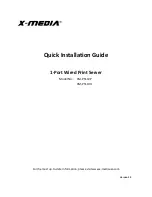
XPM 80™
Thermal Printer Family
HENGSTLER
Part No. D 690 019
Mod. No. 4 051015 Eli1
page 14 of 32
3.5.3. Upper and Lower Paper Path Entry Sensors
These sensors detect the presence of paper when it is inserted into the upper and
lower paper paths of the Dual-Feed Unit (DFU). The controller uses this information
to load paper and to determine whether paper is present in each of the paper paths.
3.5.4. Upper and Lower Paper Path Exit Sensors
These sensors detect that paper is exiting the DFU, and are part of the jam detection
and control logic system. One function is to determine if paper has been retracted
from one paper path before advancing the paper from the other path into the printer.
3.5.5. Paper Entrance / Black Mark Sensor
There is a sensor in the paper entrance area of the print mechanism that serves
several functions. First, it detects paper entering the print mechanism and signals the
controller to activate the paper advance system. Similarly, when the printer is out of
paper, this sensor detects the fact and signals the printer accordingly.
The same sensor is also used to detect Black Marks. Black Marks are blackened
areas placed on the paper during the converting process. They are generally used, in
conjunction with appropriate printer commands, to advance the paper to a specific
position after each print job. One common reason for this is to so that preprinted
information is properly located with respect to information printed by the printer itself,
for example, printing inside a preprinted box. Black marks must be located on the
back (non-coated) side of the thermal paper.
The XPM 80™ printer is designed to allow for numerous Paper Entrance/Black Mark
sensor locations during manufacturing. (The location of this sensor cannot be
changed once the printer is built.) Also, two different sensor types can be used. The
most common is the reflex or reflective sensor, where the light source and detector
are located on a single chip. Basically, the light strikes the white paper surface and
reflects back into the sensor. If enough light reflects to activate the sensor, the printer
reports that paper is present. If there is not enough light reflected, the printer
assumes that this area is black, meaning the printer is on a black mark or the printer
is out of paper. There are seven (7) different possible positions for this sensor. The
positions of these sensors are detailed in Figure 8.
The XPM 80™ can also use a through-beam sensor. This type of sensor has a
separate light source and detector. The light is transmitted across the paper path into
a prism, which redirects it back across the paper path into the detector. When the
light is blocked and cannot reach the detector, the printer reports that paper is
present. When the light does reach the sensor, the printer concludes that there is no
paper present.
The through-beam sensor can also be used in a manner similar to a Black Mark
sensor. Instead of a Black Mark, a hole is used in the paper. The through-beam
sensor is located in one of seven (7) different possible locations; the centerline
location of the paper path is the default. The positions of these sensors are detailed
in the Figure 9.
3.5.6. Head Status Sensor
An additional Head Status Sensor is used to determine whether the printhead is in
the up (do not print) or down (ready to print position). Normally, most of the heat
generated by thermal printing is transferred to the paper being printed and is removed
from the printer as the paper advances. When the printhead is up, no heat is being
transferred to the paper and the heat remains in the individual dots, allowing them to
overheat if activated repeatedly. Because this may cause permanent damage to the
printer, the XPM 80™ firmware will prevent printing or paper loading if the head is up.















































